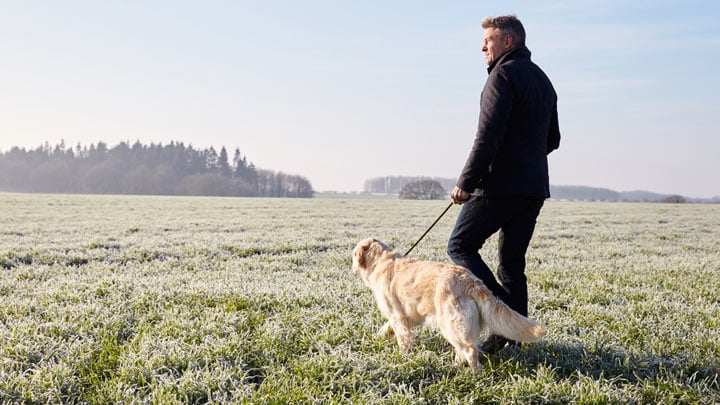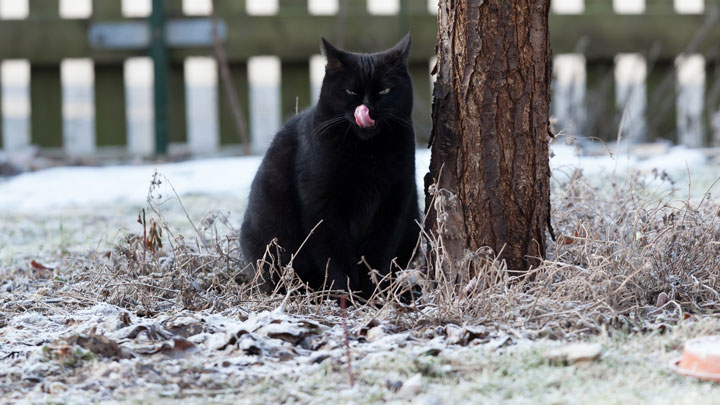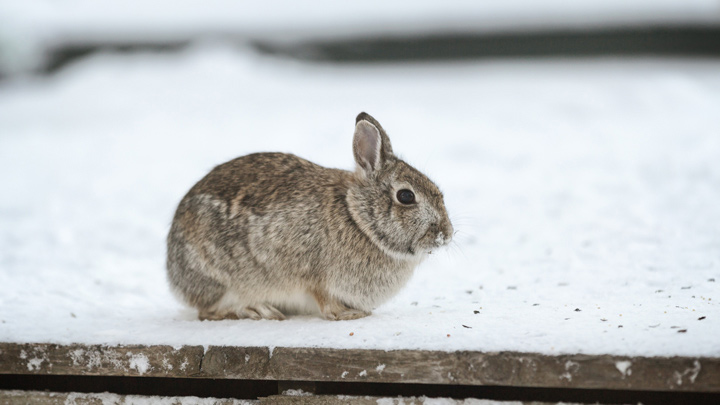Winter Safety
Winter can be a lovely time for you and your pets with magical walks through the early morning frosts or curled up by a welcome fire. But when the temperature drops it’s important to take extra care. Read our top tips to keep your pets happy and healthy during the colder months.

How to keep your dog or cat warm this winter
Your dog may have their own built-in fur coat but that doesn’t mean they’re immune to hypothermia or frostbite. Many pets live indoors for most of the year and aren’t acclimatised to longer stretches outside in very cold temperatures.
Some dog breeds have big, thick coats and are comfortable bounding around in the snow and frost such as huskies or malamutes. But short-haired breeds like terriers or greyhounds will feel the cold more.
If your dog has a thick coat, you can let it grow longer through the winter months but make sure to groom regularly to prevent knotted fur. For short-haired varieties or puppies consider buying a winter coat or doggy jumper they can wear on the coldest days.
Many cats prefer the warmth and will stay indoors more during the winter months but if yours is an outdoors type, make sure they have somewhere cosy to go e.g., and open shed. If temperatures drop extremely low, consider keeping them inside until the cold snap passes.
Tips to protect your pet’s paws
If you see your dog lifting their paws or whining when they’re on a walk it could be because their feet are cold. Doggy winter boots can be a good investment but if your pet refuses to wear them make sure you clean and dry their feet when you get home to prevent injuries – salt and grit can become trapped between the pads and cause irritation.
Similarly, ice and snow can get stuck between their pads and ball up, increasing the risk of frostbite not to mention discomfort for your dog. If it’s cold, your dog’s body will also limit blood flow to their extremities – this is good for keeping their core body temperature up but means there’s more risk of damage to their paws.
Your cat will probably stay indoors much more during the winter, and you can help reduce the frequency they go out even further by providing an indoor litter tray and a private corner to do their business.
If they do venture outside, make sure you clean their paws as soon as they come in – grit and salt used on roads can damage delicate pads causing redness and cracking and, in some cases, chemical burns. Rock salt is toxic to pets if swallowed so make sure you wash it away rather than let them lick it off themselves.

The dangers of ice for your pet
Frozen lakes and ponds can be incredibly pretty in winter but be careful when walking near them with your dog and consider keeping them on the lead. The ice might look solid but there may be thin patches or holes – your dog could fall through and drown or get hypothermia. Ice can also be surprisingly sharp and could cut your dog’s paws.
The dangers of antifreeze poisoning for your pet
Antifreeze can be extremely dangerous for cats and dogs, so it’s essential you keep it well away from your pets.
Even a small amount can cause serious kidney damage and death. You might see signs of poisoning straight away but often you won’t know for two or three days until the effects of kidney failure begin to show.
The trouble is anti-freeze smells and tastes sweet which can be particularly attractive. Most pets encounter it leaking from a car or after you’ve refilled your screen wash. If you notice a spill, clean it up straight away and if you think your pet has ingested some, see your vet immediately – the sooner they get treatment the better chance they have of surviving.
Top tips for winter walks
It may be cold and dark outside but if you’re organised you can still make the most of your winter dog walks:
- Clothes – You’ll be wrapping up warm but don’t forget about your dog. Consider buying a fleece, waterproof jacket and dog boots for your furry friend.
- Stick to well-trodden routes – Snow can hide lots of hazards like fallen branches or sharp rocks
- Wear reflective clothing – If you’re walking in the dark a reflective jacket for you and an LED collar for your dog will make you stand out
- Don’t forget lights – It’s important drivers can see you and your dog so as well as hi-vis clothing, take a torch with you to light the way.
- Plan ahead – Pay close attention to the weather forecast and plan some alternative routes if you can’t do your usual walk.
How to encourage exercise in the winter months
In this weather you’re much less likely to want to head out for a walk with your dog but just like humans, your pet can gain weight if they’re not moving as much. If venturing outdoors is off the cards, then try these tips to get them running around:
- Play a game of fetch
- Give them a treat ball containing their favourite snack
- Play tug of war
- Use a flirt pole – essentially a stick with a toy dangling on the end which they can try to jump up and catch

How to spot the signs of frostbite/hypothermia
Hypothermia occurs when your dog or cat’s temperature drops substantially, usually because they’ve been exposed to extremely low temperatures for some time.
It can be very dangerous and even fatal for animals, so it’s important you early on:
- Shivering (this will stop suddenly if their temperature falls extremely low)
- Loss of coordination
- Pale or blue lips and gums
- Low energy
is an emergency and if you think your pet is suffering contact your vet immediately and administer first aid, this includes drying them off with a towel if they’re wet, move them to a warm place and wrap them up with a blanket or a dry towel. If not treated promptly it can lead to loss of consciousness, frostbite and death.
Keeping cats indoors
The chances are your cat will stay indoors much more during the winter months but if your pet is an adventurous type, then you may have to use a few crafty tactics if you’d rather keep them inside.
Try keeping the cat flap locked and only let them outside to do their business when you’re at home. Better still, create a quiet corner with a litter tray where they can go to the toilet in peace.
If your cat becomes frustrated being inside and starts to scratch your furniture, then try these tips to keep them entertained.
Check your car for sleeping cats
Cats seek refuge in all sorts of places in winter and you’ll often find them curled up underneath a warm engine or in the wheel arch of your car. Make some loud noises to ensure there are no feline friends hiding anywhere before you start your engine.

How to keep your rabbit dry
Rabbits get colder much faster than humans and your pet can become quite sick if you don’t winterise their hutch to keep them dry and warm. Unlike rabbits who live in burrows where there is little temperature change all year round, your rabbit’s home can become pretty chilly in winter:
- Inspect their hutch for any rotten areas or cracks where draughts can whistle through and make sure the roof is completely waterproof. Replace or repair any worn out parts.
- Buy a good quality, close-fitting waterproof cover, or cover their hutch with a tarpaulin but make sure they have enough ventilation.
- If the temperature goes sub-zero your bunnies might require a little extra help to keep warm, so pop a rabbit-safe heat pad in their hutch for them to sit on (do not use a hot water bottle).
When to add extra bedding and increase food
Your rabbit needs a nice thick layer of shavings, then a layer of straw in their hutch (straw is warmer than hay and a better insulator). You can also use a cardboard box to line their hutch and put their bedding inside – it makes it extra cosy for them and easy for you to remove and clean out.
As soon as the temperature drops, you can start to add in more straw. Make sure to change the bedding regularly so they’re never sitting in a damp spot.
Rabbits tend to eat more in the winter to keep their body temperature up so add in extra food and hay throughout the colder months.
Should I bring my rabbit indoors?
It’s up to you – your rabbit will live happily outside all year round, but you can equally bring them inside for winter. It’s a good idea to do it gradually so they get used to spending increasing amounts of time in their indoor home. Just don’t bring them in every night and put them out each day as this can stress them.
If you need more information about how to keep your pet safe during winter, contact your vet.

